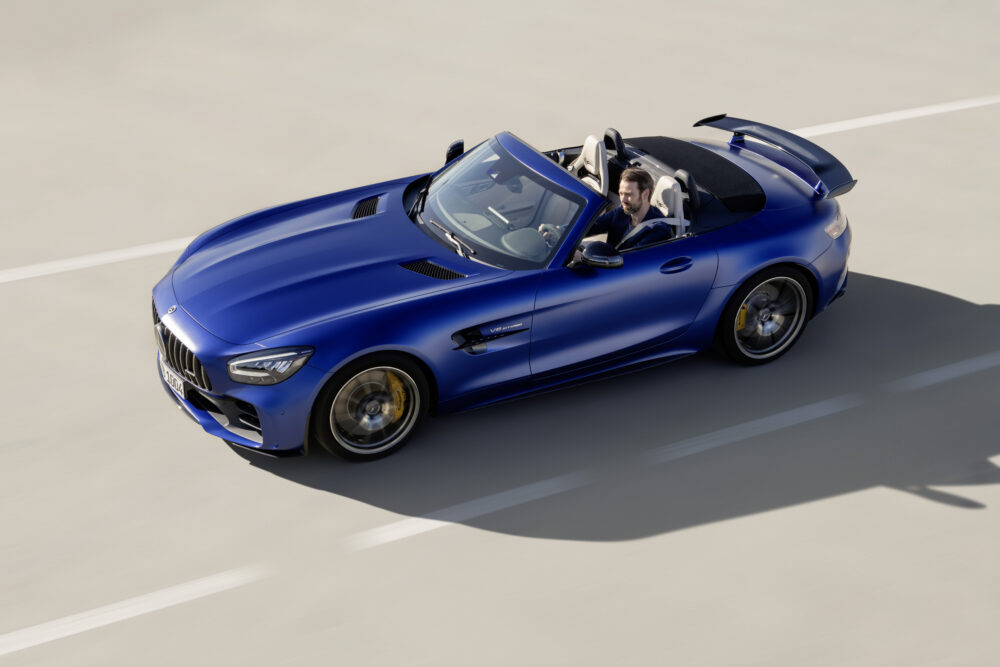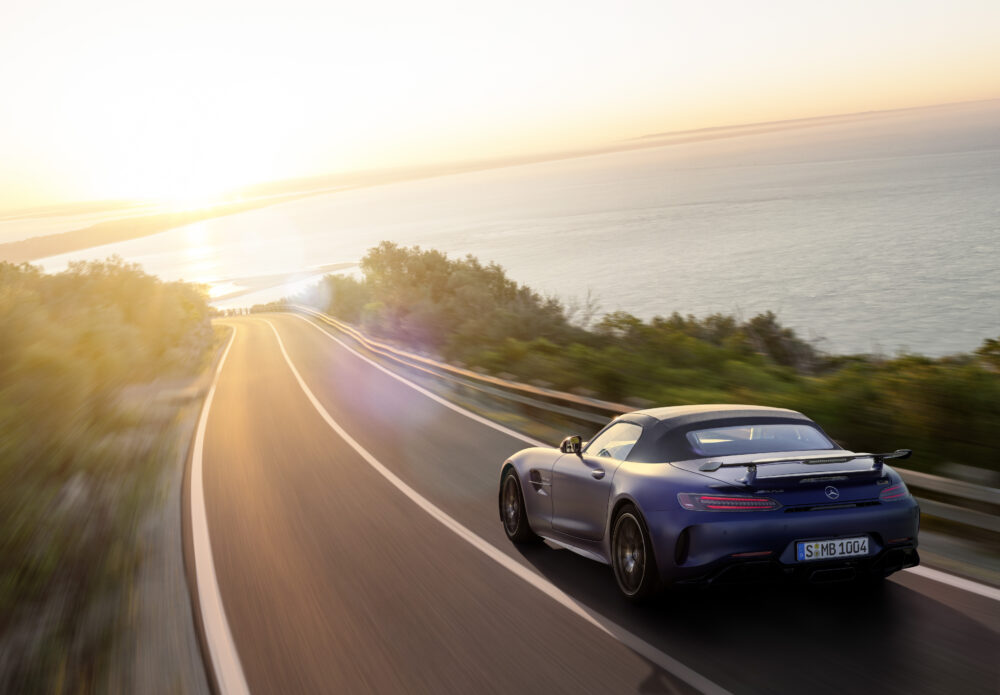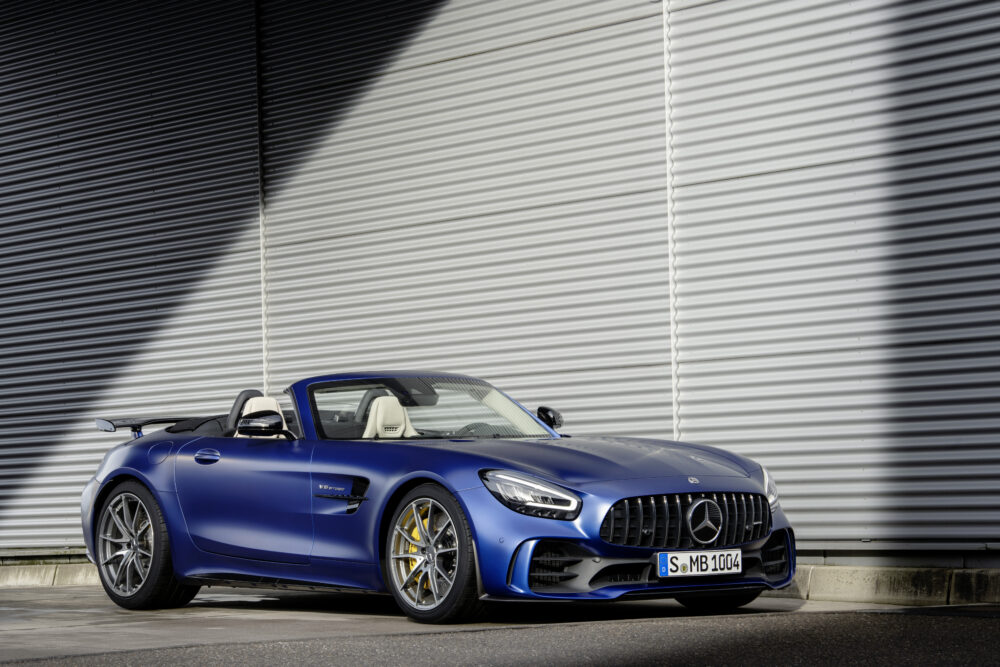2019 AMG GT R Roadster Will Be Limited to 750 Units Worldwide
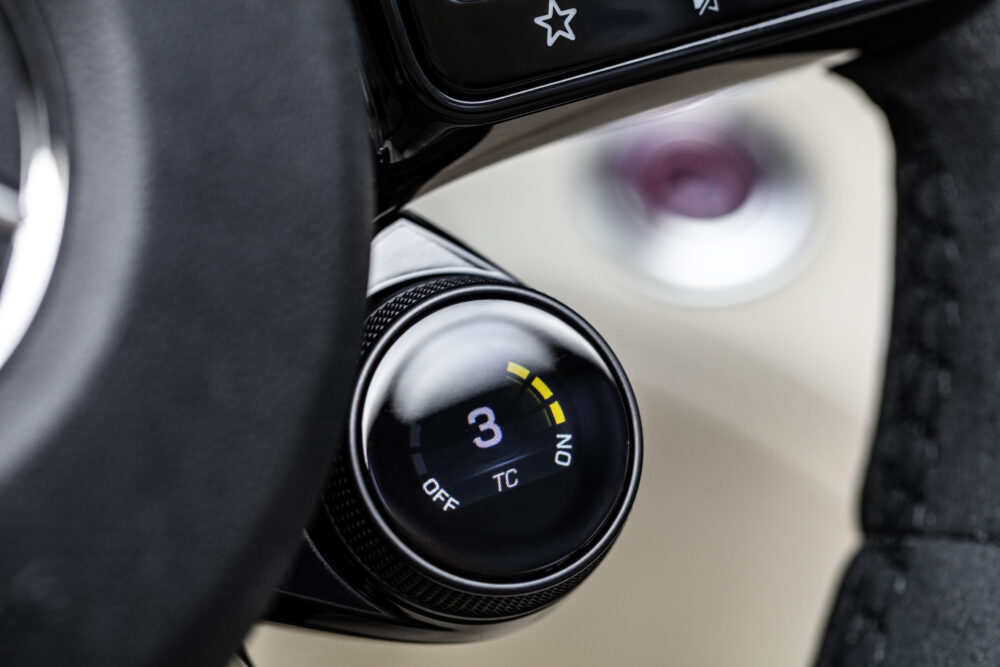
Agile Dual-clutch Transmission
The seven-speed dual-clutch transmission configured in transaxle layout at the rear axle has been made even more suitable for the racetrack by the AMG developers. First gear in the AMG SPEEDSHIFT DCT 7G has a longer ratio, while seventh gear and the final drive have shorter ratios to allow a more agile acceleration experience overall and very spontaneous response to fast accelerator pedal movements.
The previous limits governing shift performance and response time have been extended substantially. The Race Start function is now even more impressive thanks to the increased starting revs, the more sensitive wheel slip control and the sports tires fit for the racetrack. Furthermore, the transmission cooling has been adapted to the tougher requirements of high performance driving.
Dynamic Drive Modes for AMG GT R Roadster
Using the AMG DYNAMIC SELECT gearshift paddle in the center console or the AMG steering-wheel buttons, the driver can adjust the AMG GT R Roadster to suit their individual requirements. They can choose from “Slippery”, “Comfort”, “Sport”, “Sport plus”, “RACE” and “Individual”. The “RACE” mode optimally adjusts the shift strategy of the dual clutch transmission to the needs of racetrack usage – very short shift speeds and highly dynamic engine sound are included. By pressing the separate “M” button in the center console, the driver can activate the manual transmission mode in any drive mode.
As a feature in the AMG DYNAMIC SELECT drive programs, the AMG GT R Roadster also comes with AMG DYNAMICS. This integrated driving dynamics regulation expands the functions of ESP (electronic stability program) to exact dosing of power distribution at the rear axles and the characteristics of steering. In this way, the car becomes even more agile at its highest stability. AMG DYNAMICS optimizes the transverse dynamics by higher lateral acceleration, better traction and load change reactions.
Particularly remarkable: AMG DYNAMICS calculates how the vehicle will react. To do this, the system uses the available sensors that detect the speed, the steering angle or the yaw rate, for example. Based on the pilot-control principle it is possible to anticipate the vehicle behavior based on the driver’s actions and the data from the sensors. The control system reacts in this way even before the driver – and with no noticeable intervention of the system. The driver gets a very authentic driving feel with high cornering dynamics and optimum traction as well as high stability and predictable handling. This provides optimum support even for experienced drivers.
The different AMG DYNAMICS modes are: “Basic”, “Advanced”, “Pro” and “Master”. The drive program selection indicated on the multimedia display now shows the new AMG DYNAMICS symbol with the relevant additional term instead of the previous ESP symbol.
- “Basic” is assigned to the “Slippery” and “Comfort” drive programs. Here the AMG GT demonstrates exceptionally stable handling characteristics with high yaw damping.
- “Advanced” is activated in the “Sport” program. The AMG GT is then neutrally balanced. The lower yaw damping, lower steering angle requirement and enhanced agility support dynamic maneuvers such as driving on winding country roads.
- “Pro” (abbreviation for “professional”) is part of the “Sport+” program. In “Pro” the driver receives even more assistance for dynamic driving maneuvers while agility and precision are further enhanced when taking corners.
- “Master” is coupled with the RACE drive program. “Master” mode is aimed at drivers who want to experience dynamism and driving enjoyment on closed-off circuits. “Master” offers an extremely neutral vehicle balance, low steer angle requirement and more agile steering. In this way, “Master” ensures maximum agility and fully exploits the dynamic potential.
Dynamic engine & Transmission Mounts
Dynamic engine and transmission mounts are installed as standard in the AMG GT R Roadster. The engine and transmission mounts assume an important function in the case of a transaxle design: soft mounts improve comfort since they provide more effective decoupling of noise and vibration. However, handling and agility benefit from a generally stiffer mount set-up. Mercedes- AMG resolves these conflicting objectives using dynamic mounts, which adjust their stiffness continuously, and almost instantaneously to the respective driving conditions and handling.
This function is performed by a special control unit, which identifies handling situations based on CAN data, is connected to the electronic limited-slip rear differential and thus ensures optimum balanced driving dynamics. AMG has gone a step further in the implementation of this technology: the engine and transmission mounts are actuated independently of each other. The advantage is this innovative solution provides an additional improvement in driving precision and lateral dynamics.
Uniball Joint Bearings: Ultimate Pavement Grip
The chassis has also been modified. Wishbones, steering knuckles and hub carriers on the front and rear axle are manufactured entirely out of forged aluminum in order to reduce unsprung mass. The double-wishbone concept locates the wheel firmly, with minimal elastic movements. The high camber and toe-in stability results in high cornering speeds and also provides the driver with an optimum feel for the road when cornering at the extreme limits.
The uniball spherical bearings on the lower wishbones of the rear axle are directly inspired by motorsport. They are significantly more wear-resistant than wishbone bushings and due to their design have no play, which means toe-in and camber do not change even under high loads. As a result, the AMG GT R Roadster can be driven with even more precision. In addition, the rear axle is fitted with a thicker tubular anti-roll bar. It has been adapted to the heightened driving dynamics requirements of the AMG GT R Roadster and saves weight due to its hollow design.
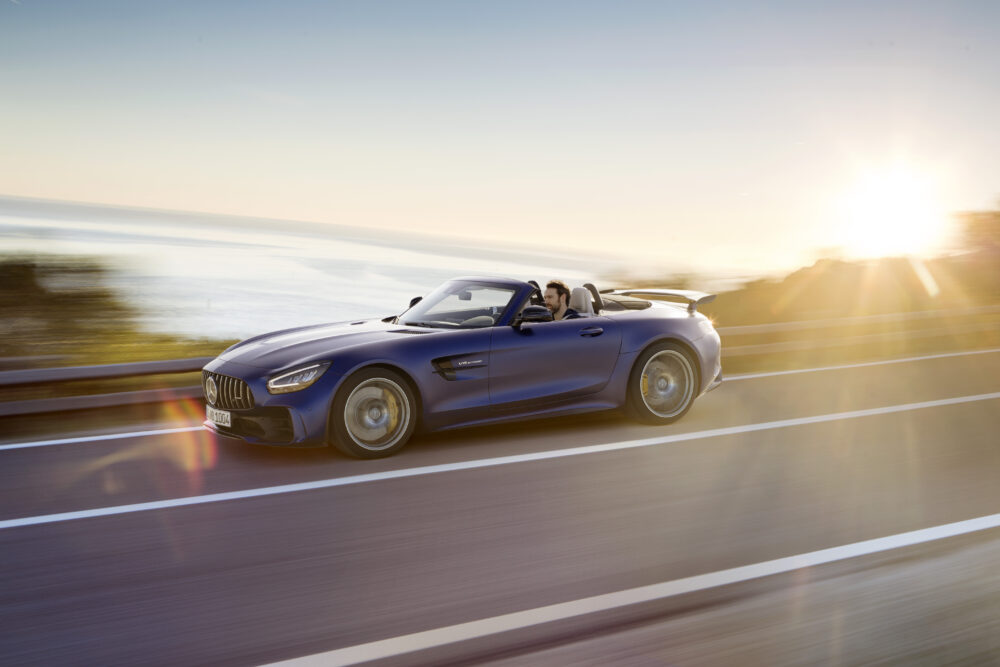
AMG Coilover Suspension with Adaptive, Adjustable Damping
As in the AMG GT R, the specially developed AMG coilover suspension is also used in the open-top variant. Its tuning can be precisely adjusted at the workshop. The technology familiar from motorsport is combined with the AMG RIDE CONTROL continuously variable, adaptive damping system. The system is controlled electronically and adjusts the damping at each wheel automatically to suit the current driving situation, the current speed and the road or track surface.
The damping characteristics are modulated rapidly and precisely by two separate valves for the rebound and compression forces in the dampers. A harder damping rate, for example when cornering and braking, effectively reduces rolling movements. The continuously variable adjustment of the damping to suit the current speed also ensures the best possible road contact and thus enhances safety, even at high speeds.
The driver can also adjust the adaptive damping characteristics at the touch of a button in the AMG DRIVE UNIT or by using the AMG DYNAMIC SELECT drive modes. Three modes are available: “Comfort”, “Sport” and “Sport Plus”. The purpose of each of the three damping characteristics is clear: “Comfort” is the right choice for public roads; “Sport” is perfect for race tracks like the North Circuit of the Nürburgring, in other words for highly dynamic driving on partially undulating racetracks with maximum surface contact. “Sport Plus” is ideal for more flat, modern Grand Prix circuits such as Hockenheim and conveys a high degree of structural rigidity.
Conventional suspension measures include the wider front and rear track as well as the standard-fit Michelin Pilot Sport Cup 2 tires, of size 275/35 ZR 19 at the front and 325/30 ZR 20 at the rear.
Active Rear-wheel Steering
The new AMG GT R Roadster is even more sensitive to steering inputs thanks to standard active rear-wheel steering. The system offers an ideal combination of agility and stability – handling characteristics that are normally in direct conflict. Two steering actuators replace the conventional control arms on the rear axle. At the heart of the system are two electro-mechanical actuators (electric motors with jackscrew) that are not mechanically connected to the steering wheel. This “by-wire” system adjusts the rear wheels within a predefined operating map by means of electronic control. The maximum track angle change on the rear wheels is 1.5 degrees.
Up to a speed of 62 mph, the rear wheels point in the opposite direction to the front wheels, corresponding to a virtual shortening of the wheelbase. The advantage is that the roadster is far more agile when steering into bends, resulting in even greater driving enjoyment and less steering effort – especially on small and winding roads, narrow racetracks on which there are multiple changes in direction, or slalom courses. Further benefits include increased maneuverability and a smaller turning circle in everyday driving situations, such as when turning or parking.
Once the car’s speed exceeds 62 mph, the system turns the rear wheels in the same direction as the front wheels, corresponding to a virtual lengthening of the wheelbase and improving handling stability. At the same time, the lateral force on the rear wheels builds up considerably faster on changes of direction, thus speeding up the response to the steering. The active rear-wheel steering not only improves cornering; it also assists the driver in the event of sudden evasive maneuvers and thus enhances active safety.
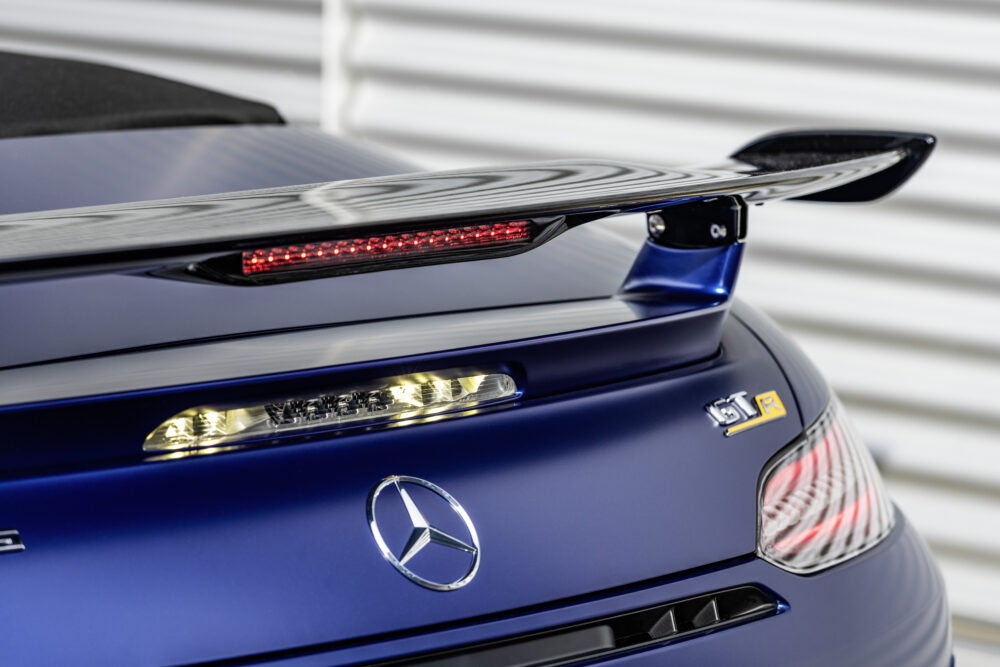
AMG Traction Control
In ESP OFF mode, another innovation allows the driver to exert even more influence on the handling characteristics of the AMG GT R Roadster. The AMG TRACTION CONTROL system comes directly from motorsport. It allows drivers to pre-select the slip on the driven rear axle in nine levels. It isolates the grip on the driven wheels and does not affect the stabilization provided by the ESP®. Corresponding characteristic maps are programmed into the vehicle electronics to this end.
Control is via the round rotary switch with an integral display on the right- hand AMG steering-wheel button. Depending on the setting, the system permits more or less slip on the rear wheels – very helpful in varying road conditions. Level 1 is programmed for driving in the wet with high safety reserves. Level 9 allows maximum slip on the rear axle. The respective setting is shown in the display on the right-hand steering-wheel button and in the central display on the instrument cluster.
The AMG development has a major advantage over conventional systems in that it anticipates situations with the help of a virtual simulator and other data processed by a control unit within fractions of a second. The maximum permissible drive slip on the rear wheels is calculated depending on the selected AMG TRACTION CONTROL level. When the wheels reach this level of slip during acceleration, the traction control modulates the engine output so that this level is not exceeded and the vehicle continues accelerating with this specified slip. The effect of the electronic limited-slip differential is also included in the adjustment scope. This control therefore takes place without lag, further enhancing both driving enjoyment and performance.
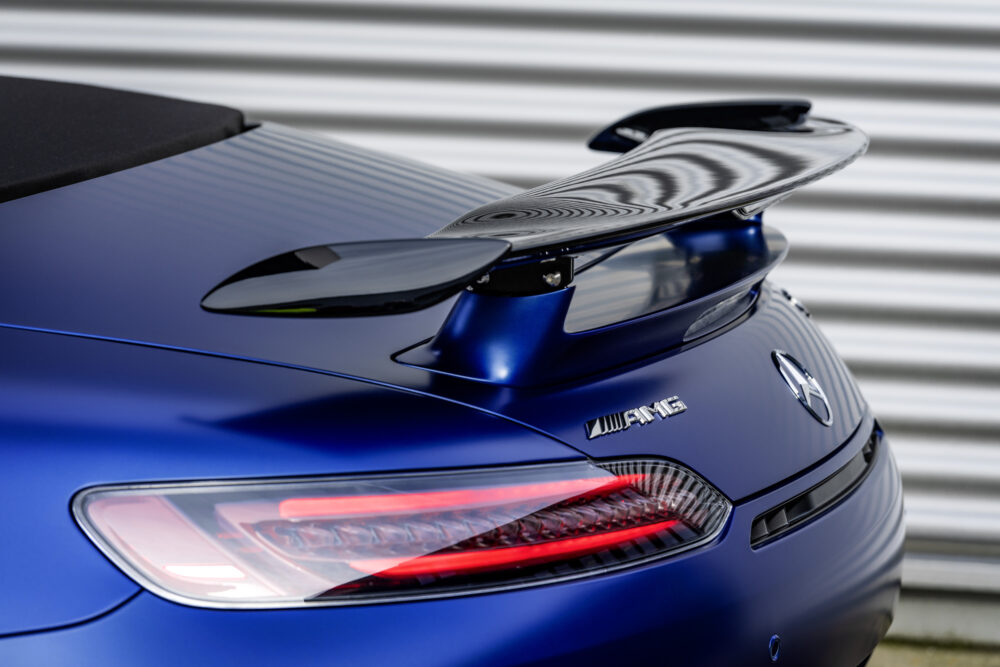
Locking Differential
As standard, the AMG GT R Roadster is equipped with an electronically controlled limited-slip differential on the rear axle, which is integrated into the compact transmission housing. Its sensitive and fast control raises the critical limit of vehicle dynamics to a new level. It not only further improves the traction of the drive wheels, but also increases the critical cornering speed. The system operates with a variable locking effect in acceleration and overrun mode, and is perfectly tuned to various handling conditions and road friction coefficients.
AMG GT R Roadster Speed-sensitive Sports Steering
The speed-sensitive sports steering features a variable steering ratio, which enhances vehicle handling and agility at low speeds while maintaining driving safety at high speeds. The power assistance is a particular highlight: it responds not only depending on the given road speed, but also according to the current lateral acceleration and the selected AMG DYNAMIC SELECT drive mode. The result: The driver has an enhanced feel for the vehicle thanks to the direct feedback from the road.
High-performance Compound Braking System
The high-performance composite brake system ensures excellent deceleration and high fade-resistance with internally ventilated and perforated brake discs of 15.3-inch diameter on the front axle and 14.2″ on the rear axle. The brake calipers are painted yellow as standard.
A ceramic high-performance composite brake system is available as an option. The advantages of this system are a weight savings of approximately 33 pounds, a longer service life and even better fade resistance thanks to the ceramic brake discs with a diameter of 15.8-inch at the front and 14.2-inch at the rear.

